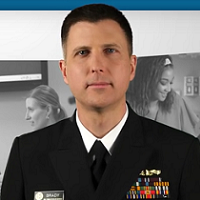 By Jeff Brady M.D., M.P.H.
By Jeff Brady M.D., M.P.H.
Rear Admiral, U. S. Public Health Service
Director, AHRQ Center for Quality Improvement and Patient Safety
Twitter: @AHRQNews
To make health care safer, we have to know when harm happens. If information about a patient safety event is incomplete or doesn’t exist, providers can’t make the necessary changes to ensure that it doesn’t happen again. Clinicians are an important source of reports about harm that occurs in health care—or safety events—when they happen. But that’s just one perspective. It’s also important to capture and understand safety events from the perspective of the patient and family.
Health care is a complex endeavor. On the road to getting better, a patient may encounter several physicians, nurses, technicians, or other caregivers and could travel through various hospital units and care settings. The patient is the single common factor throughout all these transitions and episodes of care. This makes the perspective of the patient (or family member/caregiver) invaluable to understanding what happened when harm occurs. Patients and their families often see important aspects of care, including problems that may go unnoticed by others.
Understanding that the patient perspective is important to improving patient safety is the first step. The bigger challenge is understanding how to get that input in a constructive way that’s meaningful and not burdensome to patients, clinicians, or improvement experts. As with other efforts to improve patient safety, success depends on: (1) overcoming the difficulties of collecting useful feedback and (2) translating this information into knowledge that can lead to safer care.
This is the difficult challenge that AHRQ set out to address in its Health Care Safety Hotline project. In a recent report from this project, AHRQ-funded researchers explain how they developed and piloted a prototype to explore how to get the patient perspective—all while identifying and addressing practical operational issues that could make such a system scalable for use by others in their local communities.
The project has overcome many barriers, including early concerns that asking patients and families to report patient safety events would result in over-reporting that could overwhelm an already burdened clinical staff. There were also concerns that patients and families who lack clinical experience would find it difficult to identify clinical safety issues.
In our project, researchers worked with patients and families, clinicians, experts, patient advocates, and others to develop a prototype reporting system. The system was then pilot tested in two hospitals for about 15 months. Although the pilot didn’t generate as many reports as the researchers had hoped (37 were submitted), the reports provided the patient perspective—information that wasn’t otherwise available to the participating hospitals.
In the completed reports, nearly a quarter of patients cited a communication issue as a safety concern. Other commonly reported safety concerns included the health care environment, care coordination, process or documentation issues, and problems when being discharged. Of the 37 reported safety concerns, 23 affected the patient and about half of those resulted in harm that was classified as mild by the project team. Researchers on the team used the standard scale for grading harm that is a component of the AHRQ Common Formats, which are designed to standardize reporting of patient safety events. Circumstances that were cited in the reports included: mistakes involving a prescription drug or a test; mistakes related to a diagnosis or advice from a doctor, nurse, or other health care provider; and poor cleanliness or poor hygiene. Some reports included more than one mistake. The hospitals followed up with most of the patients who completed a report to get more information and determine how to resolve the concern and improve care.
The researchers also found that a patient safety event reporting system was not disruptive to existing health system operations. Contrary to concerns from the field, patient/family reporting did not increase clinician or facility burden.
Safety events aren’t the only place where communication could be improved, the researchers say. The report suggests that better outreach approaches and a user-friendly Web site might generate more patient involvement and increase the number of reports.
The report includes materials tested in the project as well as lessons learned. The forms, specifications, and other materials could be useful to others who are interested in developing their own patient safety reporting systems.
The goal of keeping patients safe merits the testing and refinement of a wide variety of approaches that could help improve patient safety. This research breaks new ground in a challenging area that’s critical to making our health care system safer—capturing the patient and family perspective in order to prevent patient safety events. AHRQ has long advocated for patients and families to be more engaged in their care through shared decisionmaking, asking questions of their clinician, and being active members of the health care team. Engaging patients and families in safety event reporting helps bring the unique patient perspective to bear in making care safer.
This article was originally published on AHRQ Views Blog and is republished here with permission.
